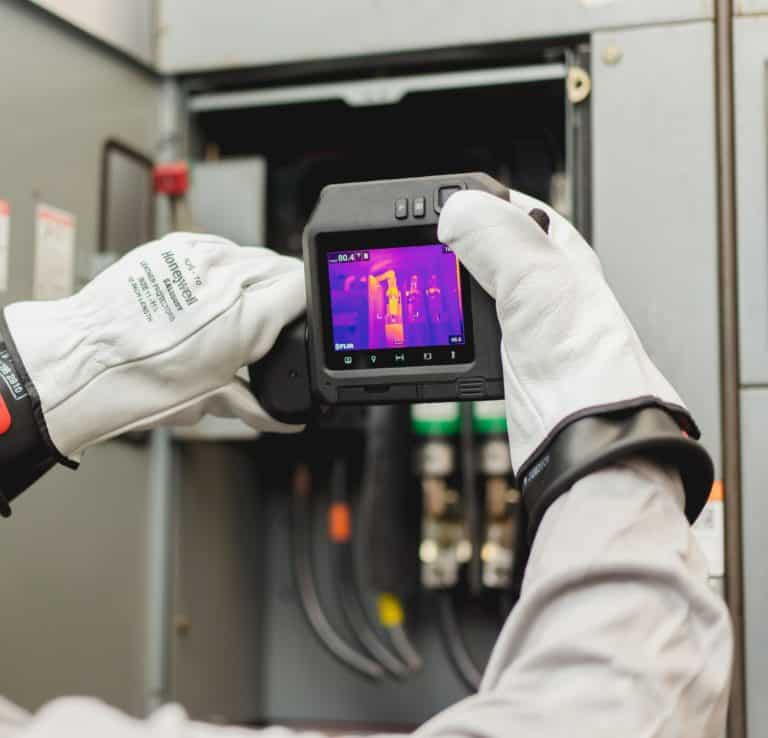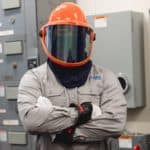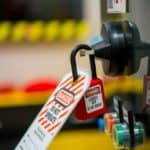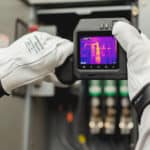Treating an electrical infrared inspection as a comprehensive program demonstrates your company’s commitment to safety, reliability, and compliance with standards. Yet far too often, organizations fail to capitalize on their opportunity to standardize and maximize their IR capabilities.
This document lays out the why and how behind implementing a comprehensive infrared program to help deliver on your safety, reliability, and sustainability commitments to your people, shareholders, and the planet.
NFPA 70B 2023 (Chapter 7.4), Standard for Electrical Equipment Maintenance, states: “Routine infrared inspections of electrical systems should be performed annually. Where warranted by loss experience; installation of new equipment; environmental; operational; or load change condition, more frequent infrared inspections, e.g., quarterly or semiannually, should be performed.”
On January 16, 2023, NFPA 70B was elevated from a recommendation to a standard.
What Can Infrared Inspections Find?
Infrared inspections can help reliability, risk, and safety managers identify thermal anomalies to help them address issues before they happen. Electrical assets can experience issues from normal use, manufacturer defects, improper or lack of maintenance. Whatever the cause of underlying issues, it is critical to find them before they impact your operation or people.
Here are some of the biggest issues an effective infrared inspection program can prevent:
Electrical Fires
Heat is an immediate indicator of an electrical asset experiencing problems. While temperature increases due to heavy loads, poor connections, internal flaws, or excessive loads — especially on weakened components — often lead to temperatures above normal operating parameters.
Equipment Damage
Switchgear, panelboards, disconnects, control cabinets, and other electrical equipment that support system operations are critical. If just one goes down because of an electrical problem, the impact could mean thousands of dollars in lost production. Many facilities experience unplanned downtime due to an electrical asset failure, often leading to significant operational impact, high repair costs, and even catastrophic results.
Insurance and Standards Compliance
Most insurance companies require regular electrical inspections. OSHA requires that all employers provide a work environment “free from recognized hazards”. It is important to demonstrate that you are taking proactive steps to protect your workers and keep your facilities safe. A managed infrared program can give your organization peace of mind when it comes to insurance and standards compliance.
SEAM Group drove $1.5 million in annual energy savings and a 98% issue closeout rate for a leading food processor. Learn How!
From Process to Program
Imagine the consequences of neglecting infrared inspections. Without a comprehensive infrared inspection program in place, you run the risk of operating your equipment blindly, waiting for failure to strike. And when it does, the results can be devastating.
Catastrophic failures result in unplanned downtime and asset loss and may also result in severe injuries.
Electrical system failures, fires, and arc flash events are just a few examples of the potentially disastrous events that can occur when undetected issues go unresolved. Don’t let your energized assets and the well-being of your personnel hang in the balance.
Take action and allow SEAM Group to help implement a robust infrared inspection program today.
At a high level, an IR program is simple:
- CONSISTENT: All your infrared inspections are performed the same way, at every location.
- CLEAR: Reporting is the same for every asset and issue, at every location.
- ACTIONABLE: You can track findings and repairs at the asset, facility, region, and company level.
- DATA-DRIVEN: You can access, view, and sort asset data for informed program management and decision-making.
Many companies do not incorporate infrared inspections into their predictive maintenance and condition-monitoring programs. Instead, they approach infrared inspections as a to-do task and rely on multiple local providers with different processes and standards resulting in inconsistent results and reports.
Does this sound familiar? It may be time to time to rethink your approach.
SEAM Group Helps You Implement a Sophisticated IR Program
To establish an effective infrared inspection program, we guide our customers through the following steps:
- SET RISK-BASED GOALS: Begin by evaluating your company’s existing infrared inspection results and process to identify areas of exposure and help set relevant objectives. Your electrical infrared inspection program should be guided by your company’s priorities, with consideration of insurance and standards requirements.
- INTEGRATE WITH PdM: An effective infrared program should fit alongside other Predictive Maintenance (PdM) technologies for a comprehensive approach. This could include vibration, oil testing, motor testing, and ultrasound inspections
- IMPLEMENT A CONSISTENT PROCESS: SEAM Group helps customers implement the most comprehensive and effective infrared inspection program available through developed processes, standardization, and consistency, delivering unparalleled results.
Globally, our thermographers follow international electrical work standards, regulations, and guidelines required by the country where work is performed. - ENSURE ROBUST REPORTING: Create your infrared inspection reports with increased safety, reliability, risk, ROI, and ESG goals in mind. With our technology platform, you can better calculate ROI with insights around energy, production loss, and compliance. In addition, we report on your reduced carbon emissions to help meet your sustainability objectives.
- TAKE REGULATORY COMPLIANCE INTO ACCOUNT: NFPA 70E Article 110.2 (B) states that “Normal operating of electrical equipment shall be permitted where a normal operating condition exists”. Normal operating conditions exist when electrical equipment is inspected regularly and there is no evidence of impending failure. IR is one of the best methods of inspection to determine if equipment is operating normally.
- DRIVE CONTINUOUS IMPROVEMENT: Regularly review your infrared inspection program results to implement best practices.
Boost Your Infrared Program Effectiveness with Technology
Your infrared program can provide visibility and actionable insights when powered by the right technology solution. Ideally, you should be able to understand the condition of your assets and your facilities in the moment and over time.
Our ViewPoint® solution will empower you to make data-informed decisions by:
- Creating a detailed inventory of your assets
- Documenting infrared and visual inspections
- Tracking the repair status of identified issues
- Reporting energy savings and carbon emission reductions
When you partner with SEAM Group, you gain access to our global team of experts who serve organizations across North America, Europe, and Asia.
We help numerous global companies think differently about their IR capabilities. Our services enhance our customers’ maintenance strategies, prevent catastrophic failures, and streamline their operations.
Let us show you how to make infrared inspections an integral part of your business success.
Curious about our capabilities? Visit our interactive floor map, and let’s chat!
The proof is in the numbers!
We have tracked the following savings for one of the major global hotel brands we serve:
-
Years of partnership: 15+ Years
-
Number of sites inspected: 600+
-
Energy savings: $6 million
-
Cost avoidance savings: $3.7 million

The Standard Inspection
1. Inspections and Reports
The technician will conduct the infrared inspection to identify electrical asset issues. The results may be a list of problems – and little else.While many inspectors include problem images in their reports, thermal images alone can be hard to understand.
2. Recommendations Are Made
The inspector will likely make recommendations for the electrical problems identified, such as repair, replacement, or upgrade. Any safety concerns will also be presented.
Beyond standard. Experience the SEAM Group Difference.
Standard Inspections
Inspections and Reports
The technician will conduct the infrared inspection to identify electrical asset issues. The results may be a list of problems – and little else.
While many inspectors include problem images in their reports, thermal images alone can be hard to understand.
Recommendations
The inspector will likely make recommendations for the electrical problems identified, such as repair, replacement, or upgrade. Any safety concerns will also be presented.
The SEAM Group Difference
The Inspection Goes Beyond Infrared
We provide three layers of inspection: visual digital, and thermal. Our thermographers take images of assets and load them into ViewPoint for identification.
We visually inspect assets to identify hazards such as tools in cabinets or wear and tear. Then, we use thermography to identify hotspots. When we find a problem, you receive a close-up image of the at-risk components.
In-Depth Asset Information
We make infrared inspections useful from the start. First, we catalog all assets with QR codes applied. We enter this data into ViewPoint® – our proprietary technology solution. Everything is centralized and accessible. ViewPoint users can filter asset data by facility and location down to asset type.
Guidance for the Path Forward
ViewPoint gives you a high-level view of all problems and assets inspected. You can filter, sort, and drill down by priority, type, cause, location, severity, etc. Problems are forecasted at different loads to reveal future-state risks. Our actionable reporting allows you to know where to focus your next steps.
Additionally, you can measure carbon emission reductions, potential energy savings, cost avoidance benefits, and production impact.
Our Support Goes Way Beyond the Report
As a global provider of safety and maintenance services to address problems found during your infrared inspection. Our team can install infrared windows, apply required safety labels, and conduct arc flash hazard analysis.
The SEAM Group Difference:
We help numerous global companies think differently about their IR capabilities. Our services enhance our customers’ maintenance strategies, prevent catastrophic failures, and streamline their operations.
Let us show you how to make infrared inspections an integral part of your business success.





